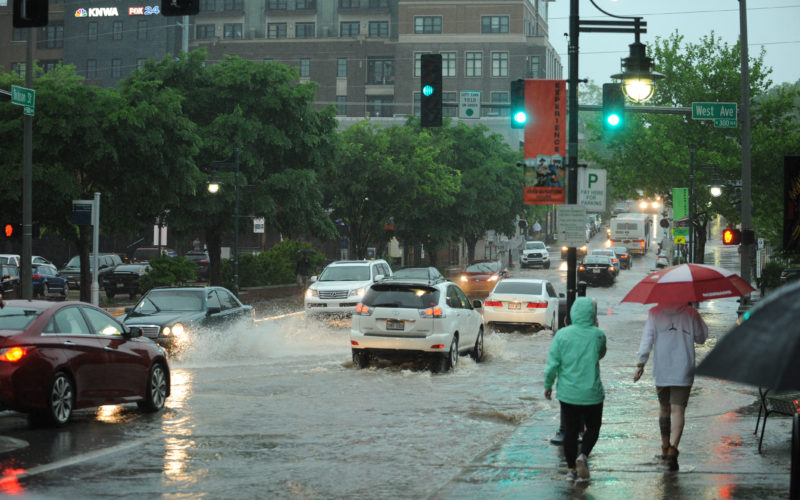Flooding focus of bond issue
STACY RYBURN
sryburn@nwadg.com

File photo/ANDY SHUPE
Traffic passes through high water across Dickson Street at West Avenue in Fayetteville after heavy rain caused torrential flooding in April 2017. The event prompted city officials find ways to pay for drainage projects, including more than $15 million included in a bond referendum.
A bond issue pertaining to drainage would help significantly reduce flooding, Fayetteville officials say.
Voters will decide April 9 on a bond referendum generating about $226 million for various projects. About $15.8 million would address flooding. Money would come from continuing a 1 percent sales tax the city already collects.
A major flooding event in April 2017 prompted city officials to take a closer look at drainage needs. Nearly 8 inches of rain fell in a 24-hour period, pouring into peoples’ homes and businesses and damaging property.
Department heads have been trying to figure out ways to prevent a repeat. The city spends about $1.5 million annually on drainage, which spans everything from street sweeping to installing culverts.
It’s enough to be reactionary, rather than preventative, according to city engineers. There’s a maintenance backlog and some areas need serious work. Covering the $15 million in projects wouldn’t be feasible with the city’s capital improvement budget, Chief Financial Officer Paul Becker said.
“We have many other priorities, and we would have to cut something else,” he said. “Right now, I don’t know where we could do that and not create other problems.”
That’s why the list of drainage projects is included in the bond package. Completing the projects wouldn’t solve all of the city’s flooding problems, but it’d significantly help, City Engineer Chris Brown said.
“Once we get this all done, the number of structures that are actually flooded should drop dramatically,” he said.
About 50 homes and businesses flooded in April 2017. The listed bond projects, combined with $350,000 dedicated to floodplain buyouts or raising homes a few feet from the ground, should protect most of those flooded structures, Brown said. The projects equate to several years’ worth of work.
The city adopted a drainage criteria manual in the mid-1990s, said Alan Pugh, the city’s certified floodplain engineer. As a result, several developments were built in flood-prone areas before regulatory measures were in place, he said.

File photo/ANDY SHUPE
Traffic passes through high water across Dickson Street at West Avenue in Fayetteville after heavy rain caused torrential flooding in April 2017. The event prompted city officials find ways to pay for drainage projects, including more than $15 million included in a bond referendum.
Fayetteville lies within an area that uplifted when the Ouachita Mountains formed about 250 million years ago, said Van Brahana, professor emeritus with the University of Arkansas’ Department of Geosciences. Most of the city’s hills are made of shale, and shale doesn’t let water soak into the ground, he said.
“You don’t need geologic training to know water flows downhill,” he said.
Other cities in Northwest Arkansas have more of a limestone bedrock, and limestone tends to dissolve from the slightly acidic rain that passes through the atmosphere, Brahana said. Thusly, other cities are flatter than Fayetteville.
“Shale has much more runoff. It’s at a higher elevation, and that water moves much more rapidly than water that can soak into the ground,” he said.
The bond projects serve as one part of the city’s plan to reduce flooding. The other part would be a fee on residents’ water bills, which would serve as an ongoing source of money for an ongoing need, Pugh said.
A study examining the feasibility of a stormwater utility fee is ongoing and is separate from the bond issue. The study incorporates the costs associated with the bond program, but isn’t dependent on it, Pugh said. Some preliminary figures on potential fees should be available by the time the vote takes place, but the City Council won’t make a decision until after then, he said.
“Right now we’re hopeful our residents will see the need and pass the bond issue,” Pugh said. “Then we’ll follow up with some candid discussions about what we do in the future, especially with the operation and maintenance and other pieces that we can’t pay for with bond dollars.”
Money from a bond issue legally can be used for a maintenance need, but it’s unwise, Becker said. However, on this particular bond issue, the statute it’s written under is for public infrastructure, which restricts its use to capital projects, he said.
The public comment period for the stormwater utility study is open. Information can be found on the city’s website.
City officials identified more than 100 potential projects after the April 2017 flooding. The bond program covers about 30.
The largest one, with a budget of more than $5 million, would overhaul the drainage system associated with Missouri Creek, near Rolling Hills Drive.
The entire area generally is bounded by Township Street to the south, Old Wire and Old Missouri roads to the east, and Sherwood Lane and Oaks Manor Drive to the west. The basin extends north where Missouri Creek enters Mud Creek, north of Brookhaven Drive.
The project would involve adding storm inlets and piping to alleviate street flooding, especially along Stanton Avenue and Rolling Hills Drive. Work on the creek would help its flowing capacity, keeping the water out of yards.
Brown said after preliminary plans are drawn up, he hopes to talk to property owners or have a neighborhood meeting to find out about other issues city officials might’ve missed in the area.
“I don’t think there will be a lot of easement acquisition, but there definitely will be some coordination,” he said. “That’s a very large project. We’ll hire a contractor to do the work, and it’ll be months and months, or a year even, of construction work.”
Another multimillion-dollar project would seek to eliminate frequent flooding near Sunbridge Drive and College Avenue. Nearly $4 million would be spent near homes along Villa Drive, which runs perpendicular from Sunbridge Drive, and businesses at the Sunbridge Drive and College Avenue intersection. The flooding presents a danger to property owners and drivers, Brown said.
A new drainage system would be installed along Elmhurst Avenue from Fairlane to McClinton streets, south of where Martin Luther King Jr. Boulevard becomes Huntsville Road. Nearly $2 million would be used to manage the water that flows from the north.
Another $725,000 would be dedicated to about 25 small projects throughout town. Other projects on the bond list have a budget smaller than $700,000 and generally came from the areas where the city received the most calls for service during the April 2017 flooding.
Mayor Lioneld Jordan said keeping residents safe is a key concern of his administration. Proper drainage helps protect properties and keep water quality high, which benefits residents’ well-being, he said.
“These drainage improvements mitigate flooding and also reduce contaminants reaching our waterways,” Jordan said. “Lives, property and water quality are all impacted by an effective drainage system.”






